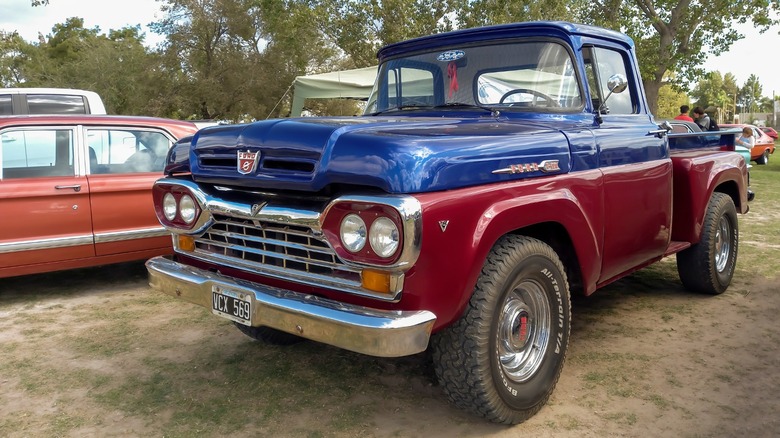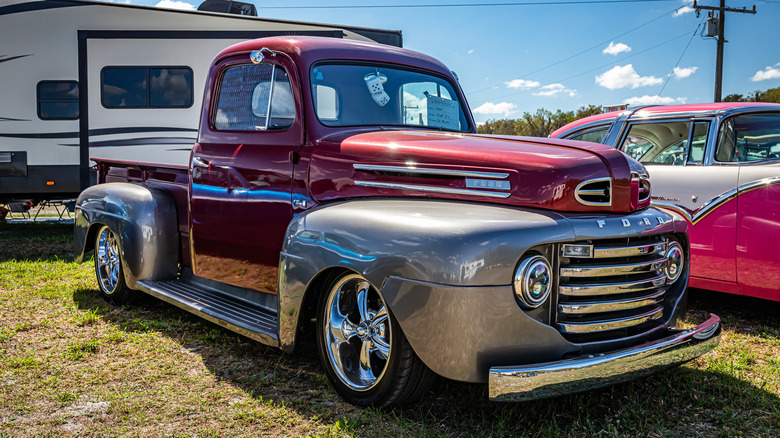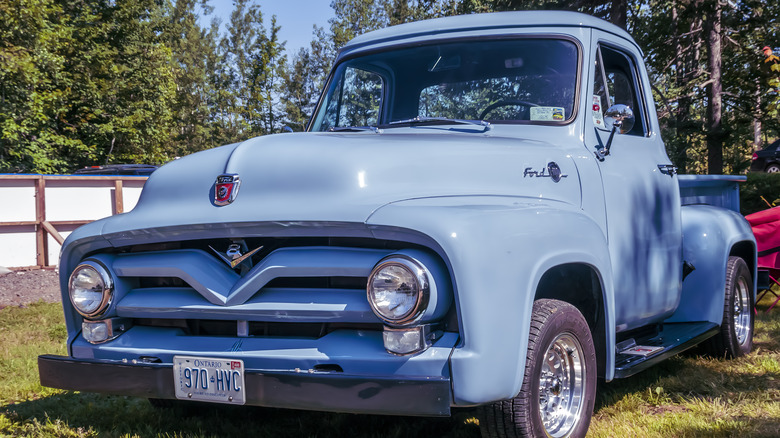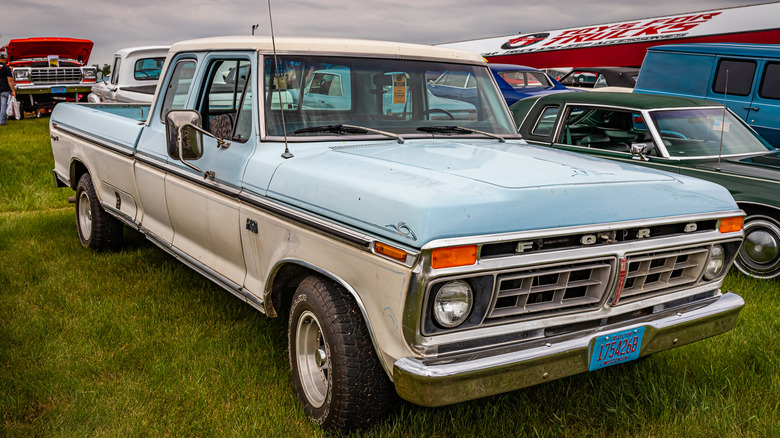Here's What Made Ford's F-100 One Of America's Most Iconic Pickup Trucks
Ever since the line's debut, Ford's F-Series vehicles have proven to be among the most popular trucks of all time. In 2023, the Ford F-150 became America's best-selling vehicle for the 42nd year in a row. Across decades, Ford has changed the formula behind the F-Series pickup truck, from EcoBoost V6 engines to electric motors and from small chassis to monstrous haulers like the F-150 Raptor R. Through it all, Ford has kept this popular lineup up to date and in demand.
In the company's 100-plus-year history of auto manufacturing, the F-100 pickup stands out as one of the most iconic Ford models ever built. From the 1950s all the way to the early '80s, the F-100 stood out as a functional workhorse that came in a light and compact package. Although discontinued, the F-100 paved the way for the F-150 to rise as Ford's best-selling vehicle today.
The F-100 truck lineup played an undeniably critical role in Ford's success across generations. So, without further ado, let's take a look at what made the F-100 one of America's most iconic pickup trucks ever and one of the best-selling vehicles Ford made for roughly 30 years.
The 1948 F-1 brought the best annual sales for Ford since 1929
Prior to Ford's 50th anniversary, the automaker's lightest truck was dubbed the F-1. Along with other offerings in the truck market, Ford's formula proved to be lucrative for the increasing truck demands after the war. Upon its 1948 debut, Ford sold over 100,000 F-1 trucks across the United States – a record for the company's truck lineups since 1929. Those numbers almost tripled in 1950.
In 1953, Ford launched the second generation of the popular truck. Along with the F-100 moniker, the new truck featured a curvier and more aesthetically pleasing design. The idea was to redefine what a truck looked like, and the 1953 Ford F-100 proved that you can bring form and functionality into one package. The stylish look, coupled with Ford's 106-hp Flathead V8, became a new benchmark for what American trucks could be.
Similar to the debut of the first-gen F-1, the 1953 F-100 became extremely popular among Americans. With over 130,000 units sold in the first year, the F-100 brought major success for Ford.
The 1954 F-100 was one of the first Ford vehicles to feature the Y-block engine
Up until the early '50s, Ford was using the same Flathead V8 powertrain it introduced to the market in the '30s. Although it was popular at first, rivals offered new and innovative engines that took the spotlight. Ford's Flathead was long overdue for a redesign. After a couple of years of research and an early appearance in Lincoln models, Ford introduced the Y-block engine for its vehicles in 1954. That same year, the new F-100 model featured this new engine.
Getting its name from its distinctive engine block shape that resembled the letter "Y," Ford's Y-block engine was a little outside of the box. It was the first Ford engine to feature an overhead valve (OHV) design. Even in its first iterations, the Y-block made up for its predecessor's lack of power by delivering 18% more horsepower to the wheels. The bigger 256 cu-in model of this engine could put out 161 brake horsepower — about 30% more than the Flathead V8's peak power.
The Y-block had a short lifespan. Although it had many impressive advantages, it also came with certain drawbacks. Some of the oil passages clogging up was one of the most common problems that the F-100 and other Ford vehicles featuring the Y-block engine faced. Nonetheless, the importance of the Y-block as a pillar for the development of the iconic Ford FE cannot be overstated.
The 1959 F-100 was Ford's first in-house 4x4 truck
The F-100 truck was a part of many major events in Ford's history, including being the company's first 4x4 vehicle to be fully developed in-house. However, it wasn't the first ever 4x4 SUV to bear a Ford badge.
The first appearance of AWD drivetrains on Ford vehicles dates back to the late 1930s, though it wasn't Ford's patent. During those times, the Woodie Wagon was one of Ford's most popular utility models, but the only available drivetrain configuration from the factory was rear-wheel-drive. Marmon-Herrington, a much smaller Indianapolis company, started producing a 4x4 drivetrain system that Woodie Wagon owners could install on their vehicles. Although the upgrade cost nearly as much as a base-model V8 Woodie by itself, it proved to have lots of potential. Later on, Ford helped manufacture some of the U.S. Army's Jeeps, which all featured 4x4 drivetrains.
It wasn't until years later, in 1959, that Ford started to compete with Jeep in the booming market of all-wheel-drive utility vehicles. Instead of relying on third-party contractors like Marmon-Herrington, Ford began making AWD drivetrains in-house for regular production, and that's how the first 1959 Ford F-100 4x4 came to be.
In 1977, the F-Series became America's favorite pickup truck
The Ford F-100 continued as one of the most popular vehicles in the U.S. through the 1960s. The sixth generation of the F-100 truck debuted in 1973 and continued to sell well on the American market, adding more comfort features like the super-cab option. To abide by the new emission regulations of the time, Ford introduced the F-150 to the market in 1975. The F-150 was intended to serve as a middle ground between the lightweight F-100 and its bigger, beefier sibling, the F-250.
The F-150 proved to be a huge success. Along with other models in the lineup, Ford's F-Series officially became America's best-selling pickup truck in 1977. To this day, the F-Series has stayed at the top of the food chain.
With the emergence of the F-150, the F-100 began fading out in popularity. Eventually, Ford quietly ceased production and discontinued its smallest pickup in 1983. Its legacy, however, lives on.




